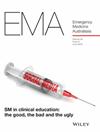Did Not Wait Patients: Low-Risk for Admission and Deterioration
Abstract
Objective
To determine the proportion of patients who are admitted to hospital following a ‘did not wait’ (DNW) encounter that are related to the initial episode of care, and to assess the frequency of clinical deterioration in this cohort.
Methods
A retrospective observational study conducted at Dubbo Health Service in Western New South Wales, Australia, using patient-level data from 29 May to 1 October 2023. Patients with a DNW episode recorded anywhere within the Western NSW Local Health District who subsequently presented to Dubbo Emergency Department (ED) and were admitted within 28 days were included. Clinical records were reviewed to determine if the admission was related to the original DNW episode and whether clinical deterioration had occurred.
Results
Out of 14,247 ED presentations, 1123 (7.4%) were classified as DNW. 315 patients re-presented to Dubbo ED within 28-days of a DNW episode of care and 32 were admitted to hospital. 26 of these admissions were related to the initial DNW episode, and 5 patients with admissions related to the initial DNW episode showed evidence of clinical deterioration (0.4% of the DNW cohort).
Conclusions
The majority of DNW episodes did not result in clinical deterioration or related hospital admission. These findings support existing evidence that challenges the assumption of high risk among DNW patients and suggest that health systems should re-evaluate performance metrics and resource investments focused on reducing DNW episodes of care.

 求助内容:
求助内容: 应助结果提醒方式:
应助结果提醒方式:


